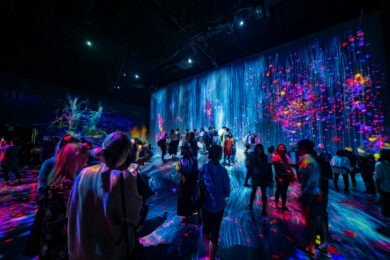An interview with MAS Chief Experiential Officer Aaron Levinthal
You remember it clearly—the last event you attended that featured an infernal racket masquerading as background music. The audio element of any meeting is essential, setting the mood and defining the energy upon attendees’ arrival. Is your event fast-paced, slow and steady or a buttoned-up formal affair? For each of these (and everything in-between), the right music is crucial to the overall enjoyment of your meeting or event.

I spoke with Aaron Levinthal, chief experiential officer of MAS, an experience agency that works “from ideation to execution to evoke emotion through bold moments—big or small, physical or digital.” When it comes to setting the soundtrack to meetings and events, Levinthal has seen it all, and shares a few key takeaways for meeting profs.
When music is not the focus of an event, not everyone fully grasps its importance. What are some reasons why the audio element is so crucial?
You’re trying, ideally, to affect the energy of your attendees in one way or the other, either to get them excited, or get them to settle in before a heavier presentation. We always encourage a live DJ, even if they’re not onstage. Then, you have a live curation of those moments and someone reacting to how anything is working. “Okay, I thought this song would work to get this effect, but it’s not. So, let’s try something different.”
You need someone in that moment just as you need a technician running your lighting for your video cues. When you try to save money by doing it with a playlist, it doesn’t evoke the same emotion and isn’t that much of a savings. It doesn’t have to be someone in a booth with lasers up on the stage.
What are some key considerations you think about when curating music? Where do you begin?
I’m a big believer in turning to professionals. Even if we’re going with a playlist, we try to put someone who understands the client, the clientele and the brand, to put a playlist together as opposed to just buying a premade playlist. We just don’t find they work so well. And inevitably, you’re standing there onsite with your client, when some song they hate comes on that you didn’t even know was on the playlist. And then you have to explain it.
Are there any “safe bet” genres for meeting profs without a budget to hire an expert? Do you have any recommendations for those who need to do it on their own?
Unless you are incredibly confident in your ability to put a playlist together—you’ve been doing it for years and all you get are compliments from all your friends who enjoy different genres—I wouldn’t take that on myself. Another great opportunity is finding a DJ you wish you could hire and ask them to make a playlist.
You could also ask your client, “Do you have anyone in-house who works for you that knows your brand and could give us some direction?” Don’t be afraid to ask your clients questions to help them solve the situation they’ve asked you to help them solve.
What are some resources you recommend to meeting profs who are new to this process?
If the venue is already chosen, go stand in the middle of it. Because that’s going to tell you how loud the space is, how reflective it feels, if there is going to be a lot of echo. Is there a lot of traffic outside, or does it make a lot of noise when I walk across the floor? Understanding the environment you’re working in is key. Maybe the goal of the music isn’t just to inspire or move people, but it’s also to cover something or highlight key moments.
I’ve never walked into a venue where the first thing I do in the center of the room isn’t slam my foot down on the floor, because it’s going to tell me so much of what I need to know. Do I need to bring in drape? What do I need to do to try and soften it? That’s always a good spot to start.
Find out if there’s a vendor you are required to use. They can tell you a lot of the things you need to know about that room such as “Every day at three o’clock a whistle goes off across the street.” With that knowledge, you can build your programming to make sure it’s not a key moment in the presentation.
Ask your clients questions. Anyone who’s been in the room before you is more of an expert than you are. One of the true goals of a producer or an event designer is to put together the best program they can before they have all the information they’ve got. It’s educated guessing. You want to get as much data as you can about the space, the people, the attendees, the presenters, the CEO of the company… If you can put those things in a single bucket, you’re going to get a pretty good sense of what you’re trying to do at those moments.
The Circular Joy of Aligned Attendees
How do you get everyone singing from the same songbook, as it were? How about a drum circle? At an activation for the new Convene 100 Stockton in San Francisco’s Union Square, Entire Productions brought the music scientists from Rhythm Quest to the 53,000-square-foot, tech-enabled venue spread over two floors in the former Macy’s Men’s Store building to bring out the playful side of a group of meeting professionals. By establishing a beat to set a shared purpose, the team made space for individual expression around the room. The result was music to this editor’s ears.
– JT Long




